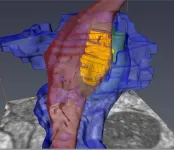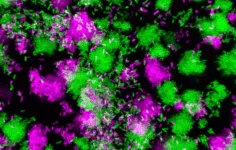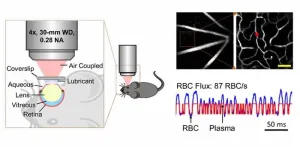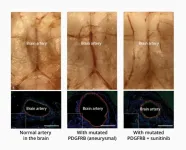(Press-News.org) Scientists have created one of the most detailed 3D images of the synapse, the important juncture where neurons communicate with each other through an exchange of chemical signals. These nanometer scale models will help scientists better understand and study neurodegenerative diseases such as Huntington’s disease and schizophrenia.
The new study appears in the journal PNAS and was authored by a team led by Steve Goldman, MD, PhD, co-director of the Center for Translational Neuromedicine at the University of Rochester and the University of Copenhagen. The findings represent a significant technical achievement that allows researchers to study the different cells that converge at individual synapses at a level of detail not previously achievable.
“It is one thing to understand the structure of the synapse from the literature, but it is another to see the precise geometry of interactions between individual cells with your own eyes,” said Abdellatif Benraiss, PhD, a research associate professor in the Center for Translational Neuromedicine and co-author of the study. “The ability to measure these extremely small environments is a young field, and holds the potential to advance our understanding of a number of neurodegenerative and neuropsychiatric diseases in which synaptic function is disturbed.”
The researchers used the new technique to compare the brains of healthy mice to mice carrying the mutant gene that causes Huntington’s disease. Prior research in Goldman’s lab has shown that dysfunctional astrocytes play a key role in the disease. Astrocytes are members of a family of support cells in the brain called glia, and help maintain the proper chemical environment at the synapse.
The researchers focused on synapses that involve medium spiny motor neurons, the progressive loss of these cells is a hallmark of Huntington’s disease. The researchers first had to identify synapses hidden within the tangle of the three different cells that converge at the site: the pre-synaptic axon from a distant neuron; its target, the post-synaptic medium spiny motor neuron; and the fiber processes of a neighboring astrocyte.
To do so, the investigators employed viruses to assign separate fluorescent tags to the axons, motor neurons, and astrocytes. They then removed the brains, imaged the areas of interest by multiphoton microscopy, and used a technique called infrared branding that employs lasers to create reference points in the brain tissue, which allowed the researchers to later relocate the cells of interest.
The team then examined the brain tissue using a serial block-face scanning electron microscope located at the University of Copenhagen, a research tool created to study the smallest structures of the brain. The device uses a diamond knife to serially remove and image ultrathin slices of brain tissue, creating 3D, nanometer scale models of the labeled cells and their interactions at the synapse.
“The models reveal the geometry and structural relationships between astrocytes and their partnered synapses, which is important because these cells must interact in a specific manner at the synapse,” said Carlos Benitez Villanueva, PhD, senior associate in Center for Translational Neuromedicine and first author of the study. “This approach gives us the ability to measure and describe the geometry of the synaptic environment, and to do so as a function of glial disease.”
In the brains of healthy mice, the team observed that astrocytic processes engaged with and completely enveloped the space around the disk-shaped synapse, creating a tight bond. In contrast, the astrocytes in Huntington’s mice were not as effective in investing or sequestering the synapse, leaving large gaps. This structural flaw allows potassium and glutamate—chemicals that regulate communication between cells—to leak from the synapse, potentially disrupting normal cell-cell communication.
Astrocyte dysfunction been linked with other conditions, including schizophrenia, amyotrophic lateral sclerosis, and frontotemporal dementias. The researchers believe this technique could greatly improve our understanding of the precise structural basis for those diseases. In particular, they point out that this technique might be used to evaluate the effectiveness of cell replacement strategies, which replace sick glial cells with healthy ones, for treating these diseases.
Additional co-authors include Hans Stephensen and Jon Sporring with the University of Copenhagen, and Rajmund Mokso with Lund University in Sweden. The study was supported with funding from the Novo Nordisk Foundation and the Lundbeck Foundation.
END
New images capture unseen details of the synapse
2023-06-14
ELSE PRESS RELEASES FROM THIS DATE:
New UCF project launched to engage a diverse, new generation of researchers to aid aging populations
2023-06-14
ORLANDO, June 14, 2023 — The number of older adults in the U.S. population is growing, expecting to nearly double by 2060, and becoming more diverse with racial and ethnic minority populations projected to increase by 105% by 2040.
“As a society, we’re not ready for that,” says Norma Conner, a professor in the University of Central Florida’s College of Nursing. “We need to be cognizant of the large population of older adults that is going to be ours to care for, and we need to have a better understanding that reflects them.”
To ...
Stanford Medicine and Stanford Institute for Human-Centered Artificial Intelligence announce RAISE-Health, a responsible AI initiative
2023-06-14
Responding to rapid advances in artificial intelligence and the urgent need to define its responsible use in health and medicine, Stanford Medicine and the Stanford Institute for Human-Centered Artificial Intelligence (HAI) today announced the launch of RAISE-Health (Responsible AI for Safe and Equitable Health). This pioneering initiative seeks to address critical ethical and safety issues surrounding AI innovation and help others navigate this complex and evolving field.
Co-led by Stanford School ...
Scientists discover small RNA that regulates bacterial infection
2023-06-14
People with weakened immune systems are at constant risk of infection. Pseudomonas aeruginosa, a common environmental bacterium, can colonize different body parts, such as the lungs, leading to persistent, chronic infections that can last a lifetime – a common occurrence in people with cystic fibrosis.
But the bacteria can sometimes change their behavior and enter the bloodstream, causing chronic localized infections to become acute and potentially fatal. Despite decades of studying the transition in lab environments, how and why the switch happens in humans has remained unknown.
However, researchers ...
Making immunotherapy safer
2023-06-14
Researchers at the University of Houston are working to make T-cell immunotherapy safer, developing a tool called CrossDome, which uses a combination of genetic and biochemical information to predict if T-cell immunotherapies might mistakenly attack healthy cells.
T-cell based immunotherapies hold tremendous potential in the fight against cancer and infectious diseases, thanks to their capacity to specifically target diseased cells, including cancer metastasis. Nevertheless, this potential has been tempered with safety concerns regarding ...
Eyeing the brain: Predicting cerebrovascular diseases with retinal imaging
2023-06-14
The brain is one of the most metabolically active organs in the human body. Although it represents only about 2 percent of the human body’s weight, it receives 15 to 20 percent of the body’s total blood supply. Disrupted blood flow to the brain over a long period of time, a condition known as “chronic cerebral hypoperfusion” (CCH), can lead to serious cerebrovascular diseases such as white matter disease.
CCH manifests as lesions in the white matter, a brain region vulnerable to problems with blood supply. Unfortunately, CCH has no available cure. An early diagnosis by visualizing the microvascular changes in the brain that occur prior to lesion ...
Phone Menu Test Detects Who May Be at Risk of Alzheimer’s Disease
2023-06-14
A new study by investigators from Mass General Brigham has found that a brief, simulated task of navigating a phone menu can detect the earliest changes in daily functioning in people at risk of developing Alzheimer’s disease. Investigators found that an older adult’s performance on the test, which can be completed in a matter of minutes, was associated with the hallmarks of Alzheimer’s disease pathology, including amyloid and tau depositions in the brain. The findings, which were published in the Journal of Alzheimer’s Disease, could help inform prevention trials testing treatments for Alzheimer’s disease before ...
When local economic inequality is high, the rich tend to be more generous
2023-06-14
Rich individuals living in communities with greater levels of economic inequality tend to be more generous with charitable giving and prosocial behaviors, according to a study published June 14, 2023 in the open-access journal PLOS ONE by Joel H. Suss from the London School of Economics & Political Science and Bank of England, UK.
Many studies have attempted to assess whether the rich are more or less generous than the poor, and whether this shifts depending on the starkness of economic inequality. Thus far, the results have been inconclusive. Previous work in this vein has been conducted at a macro level, using state, region, and country-level aggregated data. In this study, Suss ...
Ocean current comes to the rescue for Pacific island reefs
2023-06-14
Marine heatwaves are emerging as a key impact of climate change and pose a particularly significant threat to corals that form the backbone of coral reefs. Researchers have now identified a phenomenon that could help coral reef managers better plan and act for the future.[1]
Every few years, the cyclic climate pattern called El Niño arises in the tropical Pacific, causing significant changes in winds, weather and ocean temperatures. From April 2015 to May 2016, the Central Pacific witnessed one of the strongest El Niño events ever recorded.
Coral reefs were so stressed by the warmer ocean temperatures that they experienced mass bleaching, whereby the ...
'Smart' drugs can decrease productivity in people who don't have ADHD, study finds
2023-06-14
New research from the University of Cambridge and the University of Melbourne, published in Science Advances, shows neurotypical workers and students taking cognitive enhancers, or ‘smart’ drugs, may actually be inhibiting their performance and productivity.
Drugs such as methylphenidate, sold under the brand name Ritalin among others, are commonly prescribed for attention deficit hyperactivity disorder (ADHD), but are also taken by those without a diagnosis, in the belief that the drugs will enhance focus and cognitive performance.
In four double-blinded, ...
The mutant origin of brain aneurysms and the first drug treatment
2023-06-14
Researchers at the RIKEN Center for Brain Science (CBS) in Japan have discovered a set of related mutations that lead to intracranial aneurysms—weakened blood vessels in the brain that can burst at any time. The mutations all appear to act on the same biological signaling pathway, and the researchers report the first ever pharmaceutical treatment in a mouse model, which works by blocking this signal. The study was published in Science Translational Medicine on June 14.
About 5% of the population have unruptured intracranial aneurysms in blood vessels on the surface of the brain. Despite being ballooned arteries with ...







